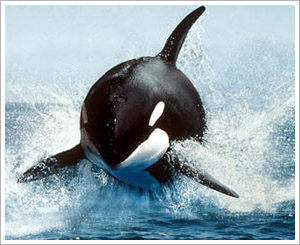Killer whales have to raise their voices to be heard over ship noise
 Washington, September 11: A new research has determined that killer whales have to raise their voices to be heard over ship noise, and the effort may be wearing the whales out as they try to find food amid dwindling numbers of salmon.
Washington, September 11: A new research has determined that killer whales have to raise their voices to be heard over ship noise, and the effort may be wearing the whales out as they try to find food amid dwindling numbers of salmon.
According to a report in National Geographic News, scientists at the National Oceanic and Atmospheric Administration (NOAA) carried out the research.
The research indicates that the killer whales of Puget Sound, a complex of inland marine waterways in the northwestern part of Washington, US, make more calls and clicks while foraging than while traveling, suggesting that such mealtime conservations are key to coordinating hunts.
“(The killer whales’) call exchange is incredibly important, and vessel noises have the potential to mask these calls,” said research leader Marla Holt of Seattle’s Northwest Fisheries Science Center, which is run by the National Oceanic and Atmospheric Administration (NOAA).
Holt and colleagues’ previous research had shown that some killer whales make louder calls to be heard over vessel rumblings—just as people raise their voices to talk over the din of a cocktail party.
Now, the researchers think the cacophony could be causing the region’s killer whales to use up more energy during hunts, even as their preferred prey, chinook salmon, are on the decline.
In Puget Sound, a small group of killer whales known as the Southern Residents has been found to be particularly well-suited to eating salmon—even down to the whales’ tooth size.
These animals don’t eat seals or other mammals, as do the transient killer whales that migrate through the sound.
In the mid- to late 1990s, the Southern Resident population mysteriously shrank by nearly 20 percent, from 97 to 88 animals. Today, there are 85 individuals.
In 2005, the federal government listed the population as endangered under the US Endangered Species Act.
No one knows for sure, but the cause was likely a combination of fewer salmon, exposure to toxic contaminants, and vessel noise, according to Lynne Barre of NOAA’s National Marine Fisheries Service Northwest Regional Office.
Holt’s work adds to existing data that have already prompted NOAA to propose a new killer whale protection law that would make all boats keep at least 600 feet (200 yards) away from the animals around Washington State.
The existing law allows boats to approach as close as 300 feet (100 yards), and some research has shown this influences the whales’ behavior.
“A lot of people would argue, Why focus on these vessel regulations?” Holt said. “But it’s one thing we can do immediately,” he added. (ANI)